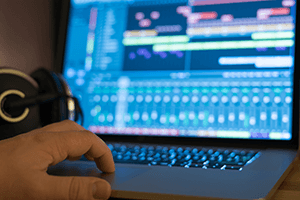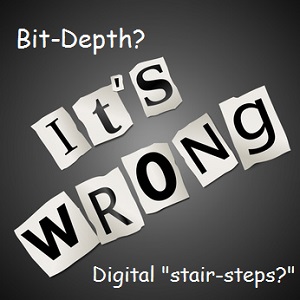 In case you didn’t already know this – if we are recording audio into our computers, we’re doing digital recording. This is as opposed to analog audio recording, which is another way of saying the way we used to do it before computers (and I include a “digital recorder” as a form of a computer) came around. Before we had easy access to those things, we had to use tape to record audio. And before that, we had to record audio direct-to either wire, vinyl or wax.
In case you didn’t already know this – if we are recording audio into our computers, we’re doing digital recording. This is as opposed to analog audio recording, which is another way of saying the way we used to do it before computers (and I include a “digital recorder” as a form of a computer) came around. Before we had easy access to those things, we had to use tape to record audio. And before that, we had to record audio direct-to either wire, vinyl or wax.
I usually try to keep explanations of such things as digital recording as simple as possible, like recording into a microphone that is plugged into a computer. I might offer metaphors like when the Master Control Program digitized Jeff Bridges in Tron, but I try not to wallow in the technical mire.
Here are a couple of my posts on the topic, which should help explain things in a more understandable way than usual (that’s my goal anyway. Let me know in the comments if I succeed!):
16-Bit Audio Recording – What The Heck Does It Mean?
A Common Misconception About Bit Depth In Digital Audio
However, there are folks who really like to wallow in the technical mire. For them I offer this article, which digs into the science of digital recording. It’s actually an excerpt from the book “The Science Of Sound Recording” by Jay Kadis.
Check it out here: http://www.prosoundweb.com/article/the_science_of_sound_recording_part_1/
Enjoy!
Ken
digital audio
A Common Misconception About Bit Depth In Digital Audio
 Would it surprise you that what is commonly taught about digital audio is actually wrong? Almost anyone you talk to – even very smart and successful audio engineers – will explain digital audio as basically a representation of sound created when a computer (an analog-to-digital converter, or just “converter” in the usual common speech) takes many “pictures” of the audio very quickly. These pictures are called “samples.” How often does a converter take these pictures/samples? The most common rate is about 44 thousand times per second (written as 44.1KHz). This is called sampling frequency.
Would it surprise you that what is commonly taught about digital audio is actually wrong? Almost anyone you talk to – even very smart and successful audio engineers – will explain digital audio as basically a representation of sound created when a computer (an analog-to-digital converter, or just “converter” in the usual common speech) takes many “pictures” of the audio very quickly. These pictures are called “samples.” How often does a converter take these pictures/samples? The most common rate is about 44 thousand times per second (written as 44.1KHz). This is called sampling frequency.
Because of the fact that audio waveforms are depicted as smooth curves – especially simple sine wave tones, it seems reasonable that discreet “pictures – static representations of something dynamic (like a still pictures compared to the movie), lined up sequentially next to each other, might get close, but could never truly capture all the real sound accurately. The tops of these “picture bars” would leave a stair-step pattern along their ends, that when laid over the actual smooth sound wave would have little gaps between the flat tops and the curve. You could get close by increasing the number of pictures, but you could never fully be accurate. Well guess what? All that is wrong! In the VERY early days of digital audio, there was some truth to it. But the technology now is such now that the whole stair-step thing is simply no longer true.
Besides, the above is talking about sampling frequency and not bit-depth. We haven’t even mentioned bits yet. Bit-depth refers to how many bits are used in each sample (picture) to convey information about dynamic range – how much of the source audio can be accurately represented in each sample. I wrote a much better explanation of this in the post – 16-Bit Audio Recording – What The Heck Does It Mean? It even uses a champagne metaphor;).
Anyway, there is a common explanation out there that bit depth is very much like “resolution” in video. It turns out that this is a bad comparison. We all know that 8-bit video is pretty sucky – all pixelated and stuff. But in audio, we’re merely talking about dynamic range. If we only had 2 bits available per sample, we could not represent enough of the original audio accurately, so there would be a lot of just noisy hiss. More bits gives us less noise, in theory. But we only need enough bits to get the noise low enough so we humans can’t hear it. Any more bits employed to reduce noise we already can’t hear seems silly doesn’t it? Why yes, yes it does. And it is! This always reminds me of the joke about two people running away from a hungry tiger. One of them says “I don’t have to be faster than the tiger. I only have to be faster than YOU!”
So 16 bits has been the standard for audio on CDs forever. With 16 bits, that low-level hiss is pushed all the way down to – 96 decibels. That is a lot more dynamic range than we really need, and allows for very quiet audio to be heard with no audible hiss. In fact, you could even go down to 8 bits and the audio would still sound a LOT better (in terms of hissy noise) than cassette tapes!
There is fantastic article about all of this where you can delve more into the nitty and (not so) gritty (ha! A resolution joke – get it?) details here: http://www.sonicscoop.com/2013/08/29/why-almost-everything-you-thought-you-knew-about-bit-depth-is-probably-wrong/
Cheers!
Ken
Bit-Crushing: Distorting Digital Audio On Purpose
Usually when I talk about digital audio and things like bit-depth (see our post – 16-Bit Audio Recording – What The Heck Does It Mean?) and Sampling Frequency (see our post – What Is Sampling Frequency?), The presumed goal is that you want your audio to be as clear and clean (free from noise) as possible. But believe it or not, there are times, especially in modern electronic dance music (EDM) when you may WANT to do the opposite. That is, you want a nasty, distorted audio sound as an effect.
In the analog days, distortion was created when physical devices, like amps, tubes, or other components in the signal, were overloaded. This is how you get that rock and roll “power chord” sound. You did it on purpose. In the digital world, things are a bit (ha!) different. You can get distortion by lowering (when to get “good audio,” you’d think “higher is better”) things like bit-depth and sampling frequency. By doing that, you are changing the shape of the audio wave form from typically curvy, to “squared off” of jagged. It’s more to do with digital audio conversion than physical gear.
That digital audio distortion and “lo-fi” sound is often sought in electronic music, and one of the common methods is called “bit-crushing.” That basically means, for example, taking something down from 16-bit to 8-bit. Here is an article that explains that in a bit more detail:
http://www.musicradar.com/us/tuition/tech/distortion-saturation-and-bitcrushing-explained-549516
Aggressive Bass For Trance And Other Electronic Music
There are seemingly endless genres and sub-genres of electronic music. While creativity is almost always a good thing, mixing and matching styles across genres can be risky. Imagine if Kirk Hammett (guitarist for Metallica) and Taylor Swift tried to do a duo. There might be some novelty to it, but its appeal would be very limited compared to a duo with Tony Iommi (guitarist for Black Sabbath) and Kirk Hammett. There are certain aspects of electronic music that are definitive of certain genres, and the bass in trance is one of those. Getting it right takes practice, but if trance is your thing, it will be time well spent.
You can read a detailed tutorial on how to produce aggressive trance bass here: http://audio.tutsplus.com/tutorials/production/quick-tip-how-to-make-an-aggressive-trance-bass/
Audio Formats And Compression
The most important difference between audio file formats is the type of compression (that’s data compression – not to be confused with audio level compression, which you can review in our article Should You Use Compression In Audio Recording? if you’d like). There are uncompressed formats (.wav, .aiff), lossless compressed formats (.flac), and lossy compressed formats (.mp3, .wma). As you might guess, uncompressed formats are in their original size and quality. These formats are best for recording, but due to their larger size, may not be appropriate for distribution. Lossless formats compress the size of the file without losing any of the quality, and lossy formats compress size with some loss of quality. Knowing the key differences between the formats can help you to choose the right file type for each step in your production process.
Get a review on the mp3 format from my article What Is An MP3?
You can read the article describing the other formats here: http://www.audio-issues.com/home-recording-studio/demystifying-audio-formats-what-format-should-you-record-in/